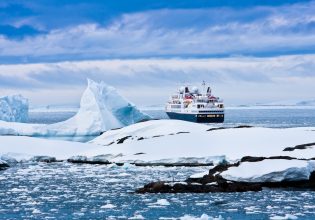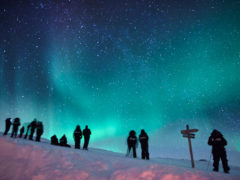Arctic to Antarctica: 5 breathtaking cultural experiences


Culture seeps into every pocket of the globe, even the most cold and remote. Head to either the Arctic or Antarctica (or both!) for a truly life-altering cultural experience.
1. Visit the world’s most remote post office
Travelling with: Jo Stewart
Despite being the only continent without a permanent population of human inhabitants, Antarctica is still home to a few cultural landmarks.

The world’s most remote post office can be found in Antarctica. (Image: Jo Stewart)
Yes, there is more to take in than penguins, orcas, seals and glaciers. You’ll find the United Kingdom’s most southerly public post office perched on a rocky outcrop just off the Antarctic Peninsula on windswept Goudier Island.

Port Lockroy is affectionately known as the Penguin Post Office. (Image: Paul Patton via Getty Images)
Affectionately referred to as the ‘Penguin Post Office’, the humble, black-and-red outpost that was once a research station is a little slice of Britain found a long way from home. A prized shore visit for cruisers, stop by to get a selfie under the Union Jack and send a postcard that is unlikely to make it home before you do.
2. Trace the routes of early explorers
Travelling with: Sarah Reid
The unique wildlife and stark landscapes of Antarctica get all the attention. But relics from the expeditions of early explorers are an unexpected highlight for many travellers. Visited on expedition cruise itineraries when weather permits, a restored wooden hut on Snow Hill Island (see Quark Expeditions) and the remains of a stone hut on Paulet Island (see Aurora Expeditions) offer a glimpse of the hardships faced by the Swedish Antarctic Expedition (1901–1903), whose members spent an unanticipated second winter in Antarctica after their ship was crushed by sea ice. Miraculously, only one soul perished before they were rescued by the Argentine Navy.

Adelie penguins reside on Paulet Island. (Image: Peter Eastway)
3. Meet the Nenets of Siberia
Travelling with: Catherine Marshall
Winters of -50°C are preferable to summer’s mosquitoes, says the Nenets boy I meet in Siberia’s Yamal Peninsula. The bone-cracking freeze makes for easier movement, too: the Nenets, who belong to one of the world’s last nomadic herding tribes, skim the ice in skidoos. In summer, when the tundra turns soggy, they dismantle their chums (tents) and move to new grazing sites in sledges pulled by samoyed dogs. The warm season has its benefits: it’s a time for preserving reindeer meat, crafting clothing from their skins and tools from their bones. The children, meanwhile, return from boarding school and learn skills that might one day help preserve this ancient tradition.

The Nenets belong to one of the world’s last nomadic herding tribes. (Image: Catherine Marshall)
4. See polar bears up close in the Canadian Arctic
Travelling with: Carla Grossetti
It’s broad daylight as the passengers onboard the Tundra Buggy press their faces against the windows of the tour vehicle, ‘oohing’ and ‘aahing’ as a polar bear and her cubs barrel past.

Keep your eyes peeled for polar bears past the Tundra Buggy. (Image: Natasha Grapes/Frontiers North Adventures)
The unique experience is part of a stay at Frontiers North Adventures’ Tundra Buggy Lodge, where you can also enjoy a meal with a view across the Churchill Wildlife Management Area in Manitoba.

Dining at Tundra Buggy Lodge affords views across the Churchill Wildlife Management Area in Manitoba. (Image: Frontiers North Adventures)
There are four immersive tours to choose from, all featuring presentations from world-renowned researchers and scientists. There are also itineraries that include a dog-sled ride through the boreal forest, blanketed in white. The lodge is located far from the lights of town, so is also in prime position for viewing the northern lights.

See the northern lights as part of this unique experience. (Image: Emilie St. Pierre/Frontiers North Adventures)
5. Get onboard with Inuit ambassadors in Greenland
Travelling with: Carla Grossetti
The colourful Inuit community of Ittoqqortoormiit is the most isolated town in Greenland, best known for its arctic wildlife, enormous icebergs and awe-inspiring landscapes. Here, the local villagers still follow ancient traditions of fishing and hunting for survival.

Dog sleds are the main mode of transport. (Image: René Loren/Getty Images)
Aurora Expeditions is providing guests on its small-ship expedition cruises with the incredible opportunity to learn about the lives of the Inuit people who are invited onboard as honoured guests and Inuit Community Ambassadors. The B Corp-certified company – founded by mountain climber Greg Mortimer and his wife Margaret – was built around a commitment to sharing knowledge and understanding about wild, remote and unspoilt destinations.

Ittoqqortoormiit, the most isolated town in Greenland, is dotted with colourful houses. (Image: Matt Horspool)
It’s doing just that through its partnership with Oxen Network and its Community Ambassador Program by creating valuable opportunities for visitors to have meaningful cultural exchanges and provide economic and social benefits to the local Inuit communities.













LEAVE YOUR COMMENT